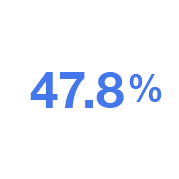We’ve assembled the following guide to help you plan your cloud migration strategy, govern data across hybrid environments, and accelerate your deployment of data and analytics capabilities to the cloud.
If you’ve asked these questions, then this guide is for you.
Why are so many companies moving to the cloud?
If it feels like everyone you know has or is moving to the cloud, you’re right. Most of us are. According to Hosting Tribunal, 94% of enterprises already use a cloud service. And the demand is only expected to grow.
Even industries that were traditionally reluctant to shift to the cloud are making the move. A recent survey shows that 42% of financial services firms and 39% of insurance companies say they have migrated data, apps, and services to the cloud in recent years. Another 25% have started this process.
We’ve all seen first-hand the value of digital transformation initiatives that helped organizations adapt more nimbly to office shutdowns, supply chain disruptions, and shifting customer expectations.
Companies whose existing cloud strategy helped them survive (and perhaps even thrive) the pandemic upheaval are likely to accelerate those investments. Those who underinvested in digital transformations are likely to kickstart new cloud initiatives.

Increase in spending on public cloud IT infrastructure year over year in 2Q20, driven by pandemic-related change
(IDC)

or lower: enterprises that have a documented cloud strategy
(Gartner)
What are the benefits of cloud migration?
Optimize operations
- Seamless scalability for dynamic workloads
- Reduced capital expenditure
- Predictable infrastructure costs
- Lower maintenance requirements
- Fast, easy access to software and hardware upgrades
- Data security
Accelerate innovation
- Rapid development/faster time-to-market
- Ready access to machine learning and advanced analytics capabilities
- Flexible for changing business needs
- Ability to capture and integrate new data fast
- Easier collaboration across distances
What should I consider before starting a cloud migration?
While of enormous benefit to companies, cloud migrations are more complex and time-consuming than many think. They require careful, calculated planning, including a clear understanding of what you expect to get out of the investment and how you will measure success.
Before you decide to migrate to the cloud, you should take the following into consideration.
1) Start with business goals and benefits
Cloud migration should start with the business strategy. It’s critical to determine which corporate initiatives can most benefit from cloud data and analytics, prioritize those initiatives, and make the appropriate business case to get the green light and get started.
Both business and technical leaders should be involved in decision-making to ensure that the cloud applications or data platform will meet all end users’ needs.
Examples of business strategies that can be enabled by cloud data and analytics
- New product development: developing and scaling product innovation concepts requires the ability to organize and rapidly modify information assets. Product innovation in the cloud strongly supports a test-and-learn capability. It also supports sharing of data and development resources across functions and regions.
- Customer acquisition and retention: operating on the cloud enables your firm to best accelerate customer experience capabilities testing and execution
- Mergers and acquisitions: analyzing data from internal and external sources is significantly enhanced in cloud architectures with almost limitless scaling capabilities.
- Demand forecasting: accurate demand forecasting models depend upon large volumes of data. The right cloud infrastructure allows you to store access and the data needed.
A global medical device manufacturer consolidated data from more than a dozen ERP systems in the cloud to get a single view of the business KPIs across multiple regions and divisions. The cloud solution gave this essential business the flexibility and scalability to dramatically ramp up production of ventilator products to quickly meet an unexpected spike in demand from COVID-19.
Watch the webinar, “The Power of Integrating ERP Data”
2) Identify what must be migrated to achieve your objectives
To the point above, you need to consider which data should and should not be migrated, what analytic capabilities will be needed, how you’ll manage and protect sensitive data, and who will have access to it. Do you plan to start with an application migration? Or, is a more complex, database migration needed?
3) Determine your cloud migration approach
Once you know what you need to move, you can determine the cloud migration approach that meets your objectives. Common approaches to consider:
- Lift and shift or rehost: With this approach, you simply “lift” or copy your applications, workloads, or databases from on-premises applications or servers to the cloud with no changes.
- Re-platform: With this approach, you go beyond lift and shift to make some optimizations that allow you to take advantage of cloud benefits, but most of the infrastructure doesn’t change.
- Refactor: Sometimes referred to as re-architecting, this approach involves modifying applications so they are optimized for the cloud environment. While this option may be more time-consuming and expensive to deploy, it typically results in a longer-term cost reduction, as it most appropriately aligns resources with your needs.
- Repurchase: Starting from scratch with an entirely new, cloud-native application.
- Retire: Eliminating applications that are no longer useful for your business needs.
4) Choose the right type of cloud environment
There are several options to consider based on your business needs. It’s rarely a one-size-fits-all or an all-or-none approach.
- Public cloud: Computing services delivered by third-party providers shared among different companies, though each company’s data and applications are private and secure. The public cloud offers more cost benefits than the private cloud. The top three public cloud providers are Amazon AWS, Microsoft Azure, and Google Cloud Platform.
- Private cloud: Cloud computing services delivered via a company’s data center or by third-party providers for use by a single organization with no resource-sharing. Though the private cloud offers more control and security, it comes at a higher cost. Private cloud is more often a choice of highly regulated industries, such as healthcare, insurance, finance, and government.
- Multi-cloud: This describes the use of multiple public or private cloud vendors. According to IDG, more than 55% of organizations use this approach today to take advantage of best-of-breed platforms and services, improve disaster recovery, and avoid vendor lock-in.
- Hybrid cloud: Leverages advantages of both public and private cloud options, with some data in a public cloud and other data in a private cloud. This option combines the scalability and cost savings of the public cloud with increased security and control of the private cloud.
- Distributed cloud: An extension of the public cloud option, in which cloud services are “distributed” among different physical locations to speed up response times and meet the needs of “location-dependent use cases.” (Gartner)
What are the steps of a successful cloud migration strategy?
Your strategy may differ slightly depending upon the factors above – whether you are moving application data vs. database or if you are rehosting vs. re-platforming. However, there are a few principles that you can always use. The clearer your strategy is, the more quickly and effectively you’ll achieve business results. This is the proven methodology that has worked well with Wavicle’s clients.
- Identify project scope
When Wavicle works with our clients to scope their application cloud migrations, we identify all applications in the environment, evaluate their performance to determine if any updates will need to be made, and decide if the updates will be made pre- or post-migration. This will include an assessment of which applications and data will perform better on hybrid vs. public vs. private clouds. This evaluation will help us decide which type of migration is most appropriate for their various applications and databases.
- Plan and coordinate teams and resources
- Whether you use an internal resource or seek outside cloud migration consulting services, you’ll want clear guidelines and an owner who will manage all of the steps of the project from start to finish. This includes mapping out resources needed, including an Architecture team responsible for licensing, providing the solution architecture, infrastructure set-up and cost management, and continued architecture oversight. We assign a valued team to create, convert and deploy jobs. Then, we work with product owners to validate data.
- Prioritize migration projects
- You may have hundreds of applications or databases to migrate to the cloud. You can’t migrate them all at once; how do you decide which goes first? There are two schools of thought on this:
- One says to start with applications that introduce the least amount of risk – or disruption – to your business. This may include applications that are not mission-critical or don’t have complex integrations or that are seasonally driven.
- The other says to start with the migrations that drive the most value to your business: perhaps driven by a new business opportunity, by performance issues that affect the business, or even based on hardware or software lifecycles. This option may mean that more complex migrations go first. In this case, you find out what works, learn from failures, and improve for the next one.
- Test the new environment
- Testing is a critical step in your cloud migration. You want to ensure your data and applications are performing properly in the new environment. This means testing for functionality, performance, and security. You must check that apps function the way you expect them to and that they integrate correctly with other apps. You’ll want to do load testing, check scalability, and verify authorizations and authentications.
- Automate where possible
- Wavicle offers a variety of accelerator tools that automate steps along the migration process to reduce time, costs, and potential errors.
A global quick-service restaurant organization migrated from a legacy Teradata data warehouse to an Amazon Redshift cloud data warehouse to get a single source of truth for worldwide daily and weekly trend reporting, as well as more sophisticated analytics on test-to-market initiatives, food delivery, supply chain, and more, for thousands of restaurants.
Learn more
How long will a cloud migration take?
Moving your data to the cloud isn’t simply a matter of flipping a switch. In addition to new storage solutions, you may be moving data to a cloud data warehouse or data lake, or a new data integration platform.
You’ll want to consider options for accelerating and reducing the extensive time, effort, and cost that goes into these development and data quality efforts. Wavicle’s cloud migration experts have developed a series of accelerators, or frameworks, to shorten cloud migration projects by weeks and months.
- Database Converter: Speeds up migration to cloud data warehouses such as Amazon Redshift and Snowflake and data lakes by ensuring database table structures are accurately converted from one database solution to another, reducing the effort by 20% – 25%.
- Data Capturer: Verifies the quality of data in the cloud. By querying tables across legacy and cloud environments, it compares contents and identifies errors so they can be quickly addressed and trust restored.
- Data Integration Code Converter: Saves months of development time by automating the replication of ETL business logic and jobs from on-premises solutions and recreating them in a cloud-based data integration solution
Cloud data integration: 9 Ways You Can Be Faster, Nimbler, Smarter with Talend Cloud
Cloud data integration solutions make it easier to handle the rapid integration of today’s volumes of data while moving data between complex cloud environments efficiently, quickly, and securely.
Download ebook
What are the costs associated with cloud migration?
Cloud computing has helped many firms reduce capital expenditures and provide more control over operational costs, but it’s important to know all the costs at play so you don’t overestimate the savings.
- Cloud infrastructure costs: Includes servers and storage. Each cloud provider offers its own calculator to help estimate costs:
- Tools and licenses: Fees for applications such as cloud data warehouse, data lake, ETL platform, and analytics tools
- Networking: Cloud provider fees associated with moving data to the cloud environment
- Security: Cost of identity access management and other systems to secure your data
- Skills: Internal skills needed to plan, deploy, and manage your cloud environment
- Professional services: Any external help needed to develop your cloud strategy, execute the migration, deploy software and applications, manage data integrity, establish governance procedures, etc.
Do I need cloud migration consulting services?
Like all large-scale projects, cloud migrations are often better left out to experts who have experience migrating applications and databases for multiple customers. Here are just a few of the reasons you should consider hiring a cloud migration consultant.
- Established frameworks: Consultants who routinely perform cloud migrations can use the successful frameworks that have allowed them to accurately and efficiently migrate cloud projects for past clients – from choosing the right leader to running tests to meet your established baselines to going live – they’ll have you covered.
- Accelerated timeframes: Some cloud migration consultants offer proprietary accelerators that can drastically reduce the time and costs of your cloud migration by automating steps throughout the process.
- Improved security: According to Gartner, most successful security attacks are actually due to human error, not cloud security issues. They recommend automating as much of your cloud migration processes as possible to reduce the potential for errors and security issues. As noted above, a consultant has the frameworks and tools in place to help you automate many steps along the way.
“Through 2022, insufficient cloud IaaS skills will delay half of enterprise IT organizations’ migration to the cloud by two years or more.”
— Gartner
How can Wavicle Data Solutions help me with my cloud migration?
Wavicle specializes in the rapid delivery of data and analytics solutions. With our cloud migration services, we help clients leverage cloud-native technologies to capture, analyze, and share growing volumes of data for advanced analytics, machine learning, and artificial intelligence.
By combining our deep technical expertise and strong industry knowledge with our proprietary accelerators, we provide enterprises with fast access to data so they can reduce risk, manage costs, increase sales, and become more efficient.
Working with leading cloud technology partners, such as AWS, Talend, Snowflake, and Databricks, we deliver fast, trusted data to drive your critical business processes.
“Wavicle Data Solutions has been one of our most trusted partners in our cloud migration journey. They provided us with a wide variety of data engineering and AWS platform expertise while offering significant flexibility in being able to quickly scale up our teams as the project ramped up. I highly recommend Wavicle for any company looking to embark on a cloud journey.”
— Luna Rajbhandari, Vice President, Data Management and Platforms, Cars.com





